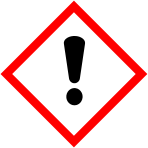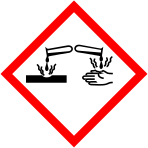SAFETY DATA SHEET
1. IDENTIFICATION OF THE MATERIAL AND THE SUPPLIER
Product Name: LEMON BLEACH
Recommended use: Bleaching in Housekeeping Areas
Supplier: Kitchen & Catering Supplies
Street Address: 5 /13 Day Rd, Rockingham WA 6168
Telephone: (08) 9592 2700
Emergency Telephone number: (08) 9419 5577 (7.00am to 4.30pm)
0419 049 003
2. HAZARDS IDENTIFICATION
CLASSIFIED AS HAZARDOUS ACCORDING TO AUSTRALIAN WHS REGULATIONS
GHS Classification(s) Skin Corrosion / Irritation: Category 2
Serious Eye Damage / Eye Irritation: Category 1 Aquatic Toxicity (Acute): Category 1


 Signal Word: DANGER Pictograms:
Signal Word: DANGER Pictograms:
| Hazard Statement(s): | H315 H318 H400 AUH301 |
|
| Prevention Statement(s): | P264 P273 P280 |
|
| Response Statement(s): | P302 + P352 P305+P351+P338 |
|
Remove contact lenses, if present and easy to do. Continue rinsing.
P310 – Immediately call a POISON CENTRE or doctor/physician.
P321 – Specific treatment is advised – see supplemental first aid instructions.
P332+ P313 – If skin irritation occurs, get medical advice/attention. P362 – Take off contaminated clothing and wash before re-use.
P391 – Collect spillage.
Storage Statement(s): None allocated.
Disposal Statement(s): P501 – Dispose of contents/container in accordance with relevant
regulations.
Other Hazards: No information provided.
3. COMPOSITION/INFORMATION ON INGREDIENTS
Recommended use: Bleaching in housekeeping areas.
Appearance: Pale yellow thin clear liquid with lemon fragrance.
| CHEMICAL ENTITY | CAS NO. | EC Number | Content |
| Water | 7732-18-5 | 231-791-2 | >60% |
| Sodium Hypochlorite | 7681-52-9 | 231-668-3 | <5% |
| Other ingredients determined to be Non Hazardous. | Not Available | Not Available | Remainder |
All the constituents of this materials are listed on the Australian Inventory of Chemical Substances (AICS).
4. FIRST AID MEASURES
Poison Information Centres in each State capital city can provide additional assistance for scheduled poisons. Ring 13 11 26
Ingestion: Immediately rinse mouth with water. Give water to drink. Do NOT induce vomiting. If vomiting occurs, place victim’s face downwards, head lower than hips to prevent vomit entering lungs. Seek immediate medical assistance.
Eye Contact: Immediately irrigate with copious quantities of water for at least 15 minutes. Eyelids to be held open. Seek medical assistance if irritation persists.
Skin Contact: Immediately wash contaminated skin with plenty of water. For gross contamination, immediately drench with water and remove clothing. Remove contaminated clothing and wash before re-use.
Inhalation: Remove victim from exposure – avoid becoming a casualty. Remove contaminated clothing and loosen remaining clothing. Allow patient to assume most comfortable position and keep warm. Keep at rest until fully recovered.
Important Symptoms: See section 11 for more detailed information on health effects and symptoms.
Notes to physician: Treat symptomatically.
5. FIRE-FIGHTING MEASURES
Fire fighting further advice: Not combustible. Fire fighters to wear self-contained breathing apparatus if risk of exposure to vapour or products of combustion.
Suitable extinguishing media: Water fog (or if unavailable fine water spray), foam, dry agent (carbon dioxide, dry chemical powder).
Special Hazards: Non combustible. Chlorine fumes may be generated in a fire situation.
Hazchem Code: None allocated.
6. ACCIDENTAL RELEASE MEASURES
Slippery when spilt. Clear area of all unprotected personnel. Wear protective equipment to prevent skin and eye damage. Contain using sand and soil – prevent runoff into drains and waterways. Use absorbent (soil or sand, inert material, vermiculite). Collect and seal in properly labeled containers for disposal.
Wear personal protective equipment as detailed in section 8 of the SDS.
7. HANDLING AND STORAGE
Storage: Ensure containers are adequately labelled and sealed when not in use. Store in a well ventilated area away from acids, organic material, oxidizing agents, foodstuffs, heat and ignition sources.
Before use carefully read the product label. Safe working practices are recommended.
8. EXPOSURE CONTROLS / PERSONAL PROTECTION
National occupational exposure limits.
Exposure standards for constituent: Chlorine TWA 1ppm (3mgm/m³)
Biological Limits: No biological limits entered for this product.
As published by the National Occupational Health and Safety Commission (Worksafe Australia).
Peak limitation – a ceiling concentration which should not be exceeded over a measurement period which should be as short as possible but not exceeding 15 minutes.
This exposure standard is a guide to be used in the control of occupational health hazards. All atmospheric contamination should be kept to as low a level as is workable. Exposure standards should not be used as fine dividing lines between safe and dangerous concentrations of chemicals. They are not a measure of relative toxicity.
Engineering Measures: Avoid inhalation. Use in well ventilated areas. The use of mechanical extraction ventilation is recommended.
Personal Protection Equipment: Wear safety goggles, PVC or rubber gloves and coveralls. If an inhalation risk exists use a Type B respirator.
9. PHYSICAL AND CHEMICAL PROPERTIES
Form / Colour / Odour: Pale yellow thin clear liquid with lemon fragrance.
Specific Gravity : 1.07 Melting Point (C): Not applicable
Rel Vapour Density: Not determined Boiling Point (C): Not determined
Vapour Pressure : Not determined Decomp. Point (C): Not determined
Flash Point: Not determined Sublimation Point: Not applicable
Flammability Limits: Not determined pH: 12.5
Autoignition Temp (C): Not determined Viscosity: Not determined
% Volatile by Volume: 96 Evaporation Rate: Not determined Solubility in Water: 100%
10. STABILITY AND REACTIVITY
Stability: Stable
Reactivity: Reacts with acids to form chlorine gas.
Hazardous Polymerisation: Will not occur.
Conditions to Avoid: Open flames, heat, sparks and other ignition sources.
Materials to Avoid: Oxidising agents, organic materials, reducing agents, metal powders, acids and any form of heat.
Hazardous Decomposition Products: May evolve oxides of chlorine when heated to decomposition.
11. TOXICOLOGICAL INFORMATION
Main Symptoms: No adverse health effects expected if the product is handled in accordance with this Safety Data Sheet and the product label. Symptoms that may arise if the product is mishandled are:
Acute Toxicity: Based on the available data this product is expected to be of low toxicity. The following data is available for Sodium Hypochlorite: Oral LD50 8910mg/kg (rat)
Ingestion: Swallowing may result in nausea, vomiting, diarrhea, abdominal pain, swelling of the larynx and subsequent suffocation.
Eye Contact: A severe eye irritant. Contamination of the eyes may result in permanent damage. Contact can cause corneal burns.
Skin Contact: Skin contact may result in irritation. May cause skin burns. .
Inhalation: Inhalation of mists may result in respiratory irritation and possible harmful corrosive effects.
Sensitisation: No sensitisation to skin or respiratory system.
Mutagenicity Carcinogenicity and Reproductive Toxicity: Not classified as a mutagen, carcinogen or reproductive toxin.
Specific Target Organ Toxicity (STOT-RE & STOT-SE): Over exposure may result in irritation to the nose & throat, coughing and bronchitis. High level exposure may result in lung tissue damage. Not classified as causing organ damage from repeated exposure.
Aspiration Hazard: Not classified as causing aspiration.
12. ECOLOGICAL INFORMATION
Ecotoxicity: No information provided.
Bioaccumulative Potential: No information provided. Persistence and Degradability: No information provided. Mobility in Soil: No information provided.
Other adverse effects: Toxic to fish and aquatic organisms. Avoid contaminating waterways.
13. DISPOSAL CONSIDERATIONS
Small spills maybe absorbed with sand, vermiculite or similar materials. Avoid contaminating waterways. Alternatively, normally suitable for disposal at approved land waste site.
Dispose of waste water according to local, state and federal regulations.
14. TRANSPORT INFORMATION
Not Classified as Dangerous Goods according to ADG7, IATA-DGR and IMDG codes.
Environmental Hazards: No information provided.
Special Precautions: No information provided.
Hazchem Code: None allocated.
15. REGULATORY INFORMATION
Poison Schedule: Classified as a schedule 5 (S5) as per SUSMP criteria.
Inventory Listings: All ingredients are listed in the Australian Inventory of Chemical Substances, AICS.
Classified and User Label Information: Classification and labelling have been performed according to regulations.
16. OTHER INFORMATION
Abbreviations and Acronyms:
ADG7 – Australian Code for the Transport of Dangerous Goods 7th edition. AICS – Australian Inventory of Chemical Substance.
Cas No – Chemical Abstracts Service Number (or CAS Registry Number). EC Number – European Community Number.
EMS – Emergency Schedules (emergency procedures for ships carrying dangerous goods). GHS – Globally Harmonised System of Classification and Labelling of Chemicals.
GTEPG – Group Text Emergency Procedures Guide.
Hazchem – Emergency Action Code of Numbers and Letters that provide information to emergency services. IATA-DGR – Dangerous Goods Regulations by the International Air Transport Association.
IMDG – International Maritime Code for Dangerous Goods. LC50- Lethal Concertation 50% / Median Lethal Concentratio. LD50- Lethal Dose 50% / Median Lethal Dose
PH – Relates to Hydrogen Ion Concentration using a scale of 0 (High Acidic) to 14 (High Alkaline). SDS – Safety Data Sheet.
STOT-RE – Specific Target Organ Toxicity (Repeated Exposure). STOT-SE – Specific Target Organ Toxicity (Single Exposure).
SUSMP – Standard for the Uniform Scheduling of Medicines and Poisons. TWA- Time Weighted Average.
This SDS summarises at the date of issue or best knowledge of the health and safety hazard information of the product, and in particular how to safely handle and use the product in the workplace. Since Challenge Chemicals Australia and its subsidiaries cannot anticipate or control the conditions under which the product may be used, each user must, prior to usage, review this SDS in the context of how the user intends to handle and use the product in the workplace.
If clarification or further information is needed to ensure that an appropriate assessment can be made, the user should contact this company.
Our responsibility for product as sold is subject to our standard terms and conditions, a copy of which is sent to our customers and is also available upon request.
Date of SDS Preparation: 16/01/2017 Edition, Revision: Edition A, Revision 3 Reason for Issue: GHS Update
